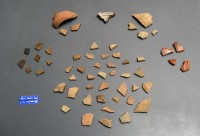 Archaeologists from the University of West Florida have identified the site of the first multi-year settlement in the United States in Pensacola, Florida. The settlement of Santa Maria de Ochuse was established by Don Tristán de Luna y Arellano in August of 1559, six years before Pedro Menéndez founded the St. Augustine colony in and 48 years before the first permanent English colony was founded in Jamestown, Virginia. Luna set sail from Veracruz, Mexico, with 1,500 people — 550 Spanish soldiers, about 200 Aztecs, colonists and African slaves — in 11 ships. The would-be colony was devastated one month after its arrival by a hurricane that sank six ships carrying their much-needed supplies.
Archaeologists from the University of West Florida have identified the site of the first multi-year settlement in the United States in Pensacola, Florida. The settlement of Santa Maria de Ochuse was established by Don Tristán de Luna y Arellano in August of 1559, six years before Pedro Menéndez founded the St. Augustine colony in and 48 years before the first permanent English colony was founded in Jamestown, Virginia. Luna set sail from Veracruz, Mexico, with 1,500 people — 550 Spanish soldiers, about 200 Aztecs, colonists and African slaves — in 11 ships. The would-be colony was devastated one month after its arrival by a hurricane that sank six ships carrying their much-needed supplies.
Without a significant Native American population in the area able or willing to provide them with food and with the next relief ship coming months later in December, the colonists had to eke out a meager existence as best they could. Documentary research suggests they moved inland to Alabama for six months only to return when what food they were able to accumulate was taken by local Native Americans, but archaeological evidence of the Luna expedition in Alabama has yet to be found. The colony was never able to thrive and only lasted two years. In 1561 the surviving colonists were picked up by Spanish ships and went back to Mexico.
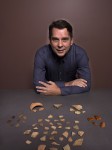 Archaeologists are keeping mum on the exact location of the site to protect it from interference. All they’ll say is that it’s a downtown neighborhood within view of two Pensacola Bay shipwrecks thought to have been part of the Luna expedition. Local historian Tom Garner found the first evidence of the settlement — 16th century Spanish artifacts — on October 2nd of this year. He was driving through the neighborhood in an area that scholars have suspected for decades may have been the site of the Luna settlement when he noticed disturbed ground on a privately owned lot where a house had recently been bulldozed. He stopped to check the spot for any artifacts and immediately noticed a fragment from the rim of a Spanish colonial olive jar and several other pottery fragments. The style of the olive jar, known as middle style, was produced for a range of time including the mid-16th century. Garner alerted University of West Florida Archaeology Institute to his find and they contacted the property owners to arrange further exploration.
Archaeologists are keeping mum on the exact location of the site to protect it from interference. All they’ll say is that it’s a downtown neighborhood within view of two Pensacola Bay shipwrecks thought to have been part of the Luna expedition. Local historian Tom Garner found the first evidence of the settlement — 16th century Spanish artifacts — on October 2nd of this year. He was driving through the neighborhood in an area that scholars have suspected for decades may have been the site of the Luna settlement when he noticed disturbed ground on a privately owned lot where a house had recently been bulldozed. He stopped to check the spot for any artifacts and immediately noticed a fragment from the rim of a Spanish colonial olive jar and several other pottery fragments. The style of the olive jar, known as middle style, was produced for a range of time including the mid-16th century. Garner alerted University of West Florida Archaeology Institute to his find and they contacted the property owners to arrange further exploration.
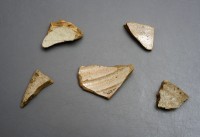 On October 23rd, Garner returned to the site and saw the jar rim was still there. He decided to collect all the artifacts he could find on the surface before they were damaged or removed. During this collection he found a fragment of Columbia Plain majolica pottery which cleanly dates to the mid-16th century. Again he alerted the UWF Archaeology Institute to the find and then returned to the site three times over the course of the next week. Garner’s surface collection returned dozens of artifacts, mostly pottery sherds, which he brought to the University of West Florida archaeology lab on October 30th.
On October 23rd, Garner returned to the site and saw the jar rim was still there. He decided to collect all the artifacts he could find on the surface before they were damaged or removed. During this collection he found a fragment of Columbia Plain majolica pottery which cleanly dates to the mid-16th century. Again he alerted the UWF Archaeology Institute to the find and then returned to the site three times over the course of the next week. Garner’s surface collection returned dozens of artifacts, mostly pottery sherds, which he brought to the University of West Florida archaeology lab on October 30th.
The artifacts so impressed UWF archaeology professor Dr. John Worth that he and his team quickly arranged a formal excavation with the permission of property owners. They were given five days, November 6th through 10th, to excavate the half-acre plot before construction of a new house began. The team did 69 shovel tests of the site.
UWF archaeologists recovered numerous sherds of broken 16th century Spanish ceramics found undisturbed beneath the ground surface. They are believed to be pieces of assorted cookware and tableware, including liquid storage containers called olive jars. Small personal and household items were also among the findings – a lead fishing line weight, a copper lacing aglet and wrought iron nail and spike fragments. Additionally, the team recovered beads known to have been traded with Native Americans. These items are consistent with materials previously identified in the shipwrecks offshore in Pensacola Bay.
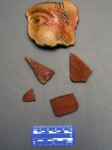 The discovery of the artifacts is additional evidence that the two Emanuel Point shipwrecks were in fact from Luna’s expedition, anchored offshore and destroyed in that devastating hurricane. The second shipwreck, discovered in 2006, is currently being excavated by UWF archaeologists.
The discovery of the artifacts is additional evidence that the two Emanuel Point shipwrecks were in fact from Luna’s expedition, anchored offshore and destroyed in that devastating hurricane. The second shipwreck, discovered in 2006, is currently being excavated by UWF archaeologists.
“The shipwrecks have provided a tremendous insight into the nature of the machinery that brought Spain to the New World and how they operated this entire vast empire,” explained Worth. “In terms of understanding who they were after coming to the New World, this kind of archaeology at the terrestrial site will provide us that window.”
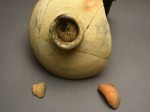 Archaeologists hope to continue to explore the neighborhood in the hopes of determining the full extent of the settlement. Its exact size is unknown. Worth believes it will cover multiple city blocks and since it’s in a residential neighborhood, further exploration relies on the permission and goodwill of the residents. UWF archaeologists had a meeting Wednesday with about 100 homeowners to explain the find and its historical significance. They were enthusiastically received and multiple residents have agreed to allow archaeologists access to their property.
Archaeologists hope to continue to explore the neighborhood in the hopes of determining the full extent of the settlement. Its exact size is unknown. Worth believes it will cover multiple city blocks and since it’s in a residential neighborhood, further exploration relies on the permission and goodwill of the residents. UWF archaeologists had a meeting Wednesday with about 100 homeowners to explain the find and its historical significance. They were enthusiastically received and multiple residents have agreed to allow archaeologists access to their property.
If sufficient numbers grant the UWF team access, Worth plans to do a few small-scale investigations in the spring before settling in for a more extensive excavation during the university’s 10-week archaeological field school this summer. If all goes well, he hopes to return every summer for the forseeable future.